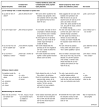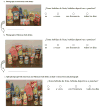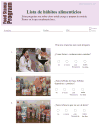Using qualitative methods to improve questionnaires for Spanish speakers: assessing face validity of a food behavior checklist
- PMID: 20102831
- PMCID: PMC4671629
- DOI: 10.1016/j.jada.2009.10.002
Using qualitative methods to improve questionnaires for Spanish speakers: assessing face validity of a food behavior checklist
Abstract
Development of outcome measures relevant to health nutrition behaviors requires a rigorous process of testing and revision. Whereas researchers often report performance of quantitative data collection to assess questionnaire validity and reliability, qualitative testing procedures are often overlooked. This report outlines a procedure for assessing face validity of a Spanish-language dietary assessment tool. Reviewing the literature produced no rigorously validated Spanish-language food behavior assessment tools for the US Department of Agriculture's food assistance and education programs. In response to this need, this study evaluated the face validity of a Spanish-language food behavior checklist adapted from a 16-item English version of a food behavior checklist shown to be valid and reliable for limited-resource English speakers. The English version was translated using rigorous methods involving initial translation by one party and creation of five possible versions. Photos were modified based on client input and new photos were taken as necessary. A sample of low-income, Spanish-speaking women completed cognitive interviews (n=20). Spanish translation experts (n=7) fluent in both languages and familiar with both cultures made minor modifications but essentially approved client preferences. The resulting checklist generated a readability score of 93, indicating low reading difficulty. The Spanish-language checklist has adequate face validity in the target population and is ready for further validation using convergent measures. At the conclusion of testing, this instrument may be used to evaluate nutrition education interventions in California. These qualitative procedures provide a framework for designing evaluation tools for low-literate audiences participating in the US Department of Agriculture food assistance and education programs.
Copyright 2010 American Dietetic Association. Published by Elsevier Inc. All rights reserved.
Conflict of interest statement
STATEMENT OF POTENTIAL CONFLICT OF INTEREST: No potential conflict of interest was reported by the authors.
Figures







References
-
- Lessler J, Tourangeau R, Salter W. Questionnaire design in the cognitive research laboratory: Results of an experimental prototype. Washington, DC: National Center for Health Statistics; 1989. Series 6, No. 1.
-
- Townsend MS, Sylva K, Martin A, Metz D, Wooten-Swanson P. Improving readability for an evaluation tool for low-income clients using visual information processing theories. J Nutr Educ Behav. 2008;40:181–186. - PubMed
-
- Townsend MS, Kaiser LL, Allen LH, Joy AB, Murphy SP. Selecting items for a food behavior checklist for a limited resource audience. J Nutr Educ Behav. 2003;35:69–82. - PubMed
-
- Townsend MS. Evaluating food stamp nutrition education: Process for development and validation of evaluation measures. J Nutr Educ Behav. 2006;38:18–24. - PubMed
Publication types
MeSH terms
Grants and funding
LinkOut - more resources
Full Text Sources

